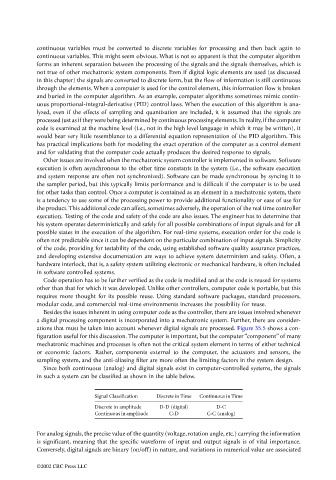Page 1026 - The Mechatronics Handbook
P. 1026
continuous variables must be converted to discrete variables for processing and then back again to
continuous variables. This might seem obvious. What is not so apparent is that the computer algorithm
forms an inherent separation between the processing of the signals and the signals themselves, which is
not true of other mechatronic system components. Even if digital logic elements are used (as discussed
in this chapter) the signals are converted to discrete form, but the flow of information is still continuous
through the elements. When a computer is used for the control element, this information flow is broken
and buried in the computer algorithm. As an example, computer algorithms sometimes mimic contin-
uous proportional-integral-derivative (PID) control laws. When the execution of this algorithm is ana-
lyzed, even if the effects of sampling and quantization are included, it is assumed that the signals are
processed just as if they were being determined by continuous processing elements. In reality, if the computer
code is examined at the machine level (i.e., not in the high level language in which it may be written), it
would bear very little resemblance to a differential equation representation of the PID algorithm. This
has practical implications both for modeling the exact operation of the computer as a control element
and for validating that the computer code actually produces the desired response to signals.
Other issues are involved when the mechatronic system controller is implemented in software. Software
execution is often asynchronous to the other time constants in the system (i.e., the software execution
and system response are often not synchronized). Software can be made synchronous by syncing it to
the sampler period, but this typically limits performance and is difficult if the computer is to be used
for other tasks than control. Once a computer is contained as an element in a mechatronic system, there
is a tendency to use some of the processing power to provide additional functionality or ease of use for
the product. This additional code can affect, sometimes adversely, the operation of the real time controller
execution. Testing of the code and safety of the code are also issues. The engineer has to determine that
his system operates deterministically and safely for all possible combinations of input signals and for all
possible states in the execution of the algorithm. For real-time systems, execution order for the code is
often not predictable since it can be dependent on the particular combination of input signals. Simplicity
of the code, providing for testability of the code, using established software quality assurance practices,
and developing extensive documentation are ways to achieve system determinism and safety. Often, a
hardware interlock, that is, a safety system utilizing electronic or mechanical hardware, is often included
in software controlled systems.
Code operation has to be further verified as the code is modified and as the code is reused for systems
other than that for which it was developed. Unlike other controllers, computer code is portable, but this
requires more thought for its possible reuse. Using standard software packages, standard processors,
modular code, and commercial real-time environments increases the possibility for reuse.
Besides the issues inherent in using computer code as the controller, there are issues involved whenever
a digital processing component is incorporated into a mechatronic system. Further, there are consider-
ations that must be taken into account whenever digital signals are processed. Figure 35.5 shows a con-
figuration useful for this discussion. The computer is important, but the computer “component” of many
mechatronic machines and processes is often not the critical system element in terms of either technical
or economic factors. Rather, components external to the computer, the actuators and sensors, the
sampling system, and the anti-aliasing filter are more often the limiting factors in the system design.
Since both continuous (analog) and digital signals exist in computer-controlled systems, the signals
in such a system can be classified as shown in the table below.
Signal Classification Discrete in Time Continuous in Time
Discrete in amplitude D-D (digital) D-C
Continuous in amplitude C-D C-C (analog)
For analog signals, the precise value of the quantity (voltage, rotation angle, etc.) carrying the information
is significant, meaning that the specific waveform of input and output signals is of vital importance.
Conversely, digital signals are binary (on/off) in nature, and variations in numerical value are associated
©2002 CRC Press LLC

